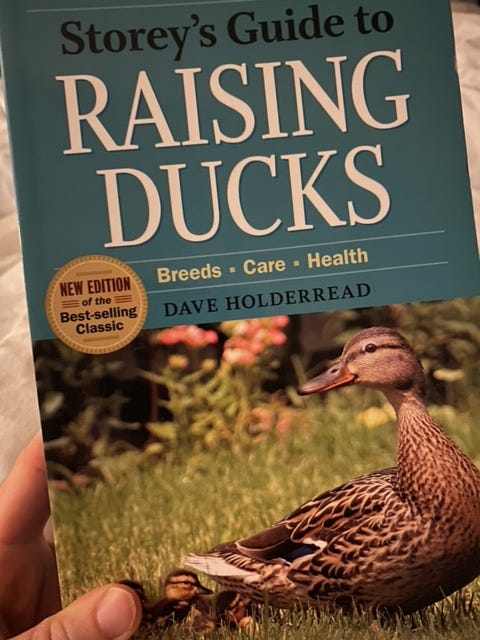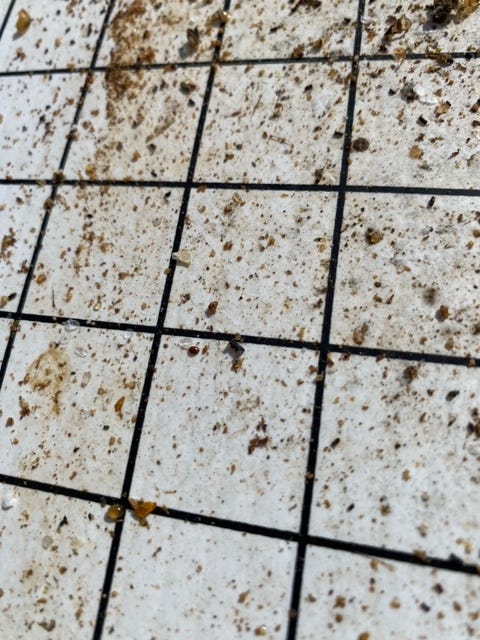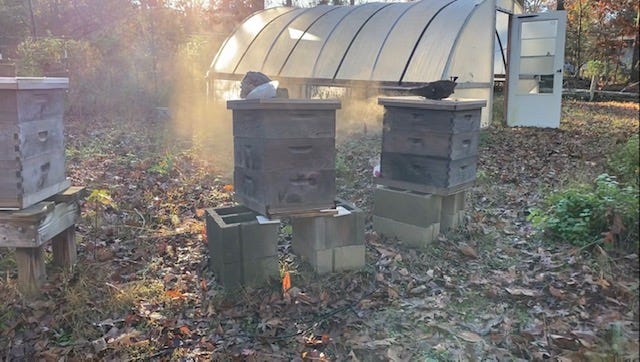Day in the life: Beekeeping in the fall in the South
Let’s take a look at what I call the most tumultuous time for honey bee colonies.
Before we look at my recent hive inspection routine, I’m happy to share I’ve launched a beekeeping mentorship program. Several folks reached out last year asking for this. The program offers one-time, 6-month, and 1-year packages. If you’re a paid subscriber to this blog, you’ll get your blog subscription comped with the 6-month and 1-year packages. Those packages also include generous discounts on hive purchases, when available.
Main goal of each season and each inspection
Every hive inspection needs a primary goal and the same approach applies to each season. Fall is a time for the colonies to focus on preparing for winter survival. Late Varroa control, queen health confirmation, and adequate food helps set colonies up for a successful winter.
In the fall here in North Carolina I focus on removing pressures and threats. Throughout the year I implement different Varroa control measures (which could be a blog series in itself). This helps support healthy brood. At some point in the fall the queen stops laying. I wait for the absence of brood to do a final Varroa mite treatment of the year. An oxalic acid vaporization treatment is recognized in chemical-free beekeeping practices and is most effective when a colony doesn’t have capped brood. That’s my go-to option in the fall.
Aside from brood checks, I also look at food. In my region of North Carolina, most beekeepers follow a general guideline to have a full super (10 frames in a traditional Langstroth hive) of honey going into winter. I like to point out that this is a general guideline and, as in all things beekeeping, it really depends on other factors. Are we having a warm fall? Yes. That means there’s a risk that colonies could eat through their honey reserves in advance of winter. Watching food levels can help move resources between colonies, prompt the need to make bee tea (syrup), or offer other food supplements.
Fall threats to honey bees
The main threat I experience each fall is pest pressure, primarily robbing. I’ve lost great colonies to robbing very quickly. After those experiences I now use robbing screens on all hives and reduce each colony to one small entrance. Other pest issues I’ve battled in the fall include Varroa madness and small hive beetles. Fall is not the time to start Varroa control efforts. Although many factors come into play, generally colonies suffering high Varroa loads by fall will be weak. They won’t be able to defend themselves well to robber bees, police small hive beetles, produce enough of a healthy population to discourage wax moths, not build the population up enough to keep the queen warm for the winter, or effectively forage and bring in enough food. It’s a devastating, fatal domino effect. Thoughtful, year-round Varroa management is the best strategy for fall colony survival.
Hive inspection routines
For my hive inspections, the big shift in the fall is that I have no need for early morning hive inspections since I don’t need to avoid mid-day summer heat. (Check out my Day in the life of beekeeping in the summer in the South.) Lunch time hive inspections become the norm in the fall, which frees up my mornings. Here’s a recent day plus another morning:
6:45 a.m. – Get up and make first breakfast: homemade yogurt and pumpkin granola.
6:55 a.m. – Sunrise.
7:00 a.m. – Go to the gym for strength training. I like to think of this time as training for picking up heavy hives in the spring and summer. Fall and winter are the only seasons when I have routine time to visit the gym. In the past few years I’ve learned to freeze my gym membership during the other half of the year because the bees and garden take up my extra time then.
7:45 a.m. – Drive country roads from Chatham County out to Alamance County.
8:10 a.m. – Pick up flour at Lindley Mills. Remember I planned to start a seasonal bakery this fall? The kitchen I’ll rent is having some delays, so I’ve postponed my bakery plans until Fall 2025. I’m still baking plenty for myself at home.
8:30 a.m. – Make second breakfast: Poached eggs from our girls over a leftover sweet potato with EVOO and pepper flakes. I let the water boil while I shower.
8:50 a.m. – Log on to work and Zoom life.
12 p.m. – Review my bee journal notes to see which colonies need their final full inspections of the season. I have 3 more to go in this apiary. Out of these colonies, one is nearly 100% full of honey—three boxes full!—and I wonder if they’re queenless since I didn’t find a queen or brood. I might combine them with another colony in a few weeks. Another colony is the only one that still has brood—and I even saw the queen laying fresh eggs. This is atypical this late in the season and the colony will need to work extra hard to keep the brood nest warm enough (about 95F) to prevent the brood from dying. I note that this particular colony might go through their food faster, not only to keep the brood warm, but to feed all of the brood too. Although I would prefer all colonies to be broodless for an oxalic acid vaporization treatment, I don’t want to prevent doing the treatment just because one colony still has brood. I plan to treat all the colonies on the next morning that I’m free and the weather cooperates.
1:15 p.m. – Back to work.
4:45 p.m. – I turn off the computer and check my personal calendar and the weather forecast. The next time everything aligns for an oxalic acid treatment is Saturday morning. These treatments are ideally done at sunrise before bees start foraging so that the entire colony receives the treatment. While there is no temperature threshold or dependency like certain Varroa treatments that can’t be done in excessive heat or when the temperatures are too low, an oxalic acid vaporization is more effective when temperatures are above 40F so that the colony isn’t in a tight cluster staying warm. Being out of a cluster allows for better distribution of the vapor.
4:50 p.m. – My beekeeping mentor had dropped off the oxalic acid tools earlier in the week, which we share. I start organizing and lining up the supplies I’ll need for the weekend treatment. Learn how I save time with oxalic acid treatments.
5 p.m. – I take the dog for a quick walk since daylight is fading.
5:13 p.m. – Sunset.
5:15 p.m. – Harvest a salad and some pumpkins from the garden. I plan to roast a pumpkin over the weekend.
5:30 p.m. – Gather eggs from the chickens and check on the quail. The quail stop laying eggs in the fall and winter.
5:45 p.m. – Make dinner. Pork chops from the pigs we raised, potatoes (not my homegrown ones since I had my first crop loss this year due to potato bugs), and the garden salad of arugula, radishes, a honey vinaigarette and pumpkin-spice cheese I found at Southern Whey in Southern Pines.
6:30 p.m. – Dinner time.
7 p.m. – Clean up the kitchen.
7:30 p.m. – Since there’s still no hard frost in sight on the forecast, I pick out more seeds to plant in the garden in the coming weekend: Arugula, lettuces, radishes, beets, snap peas, cauliflower, and broccoli.
8 p.m. – Watch old episodes of “30 Rock” with my husband.
9:30 p.m. – Time for bed. Start reading a book about raising ducks.

9:45 p.m. – Sleepy time.
On the following weekend. My Saturday morning started off:
6:30 a.m. – Get up and have a small snack: Date and peanut butter with pumpkin seeds. I had lined up all the oxalic acid treatment supplies and set up the extension cord already in the days before.
6:50 a.m. – Start bringing supplies (fire extinguisher, bucket of water, etc.) out to the first apiary.
6:59 a.m. – Sunrise.
7:05 a.m. – Suit up. In addition to my typical beekeeping gear, on oxalic acid treatment days I wear protective goggles and an N-95 mask. It’s very uncomfortable, but the temporary discomfort is worth the protection and avoiding long-term vision or respiratory issues.
7:10 a.m. – Start treating the first hive. Each hive requires 2.5 minutes of powered vaporization, then the power is cut and the wand remains in the hive for 2 more minutes. Then the wand is removed and the hive stays sealed for 10 minutes. I need to repeat this for 5 hives in this apiary.
8:10 a.m. – All hives in the first apiary were treated. I had no issues and all treatments went as planned.
8:25 a.m. – Moved the extension cord and supplies over to the second apiary where I need to treat 2 more hives. I had to go in the house to get the shed key, which I forgot to take with me. I plugged the extension cord into the shed and set up the first hive treatment. After 4.5 minutes when I removed the wand, the oxalic acid hadn’t vaporized. I tested the other outlet in the shed and it had no power as well. I re-routed the extension cord and plugged it into the house. The cord was just long enough to reach the hive with no slack to spare.
8:45 a.m. – Treated both hives successfully.
9:10 a.m. – Packed up all supplies to take out to my mountain apiary.
Why was there no shed power? I later learned my husband had turned the breaker off to the shed and had forgotten to turn it back on. Another task to add to my prep list to avoid this problem next time. ✔






